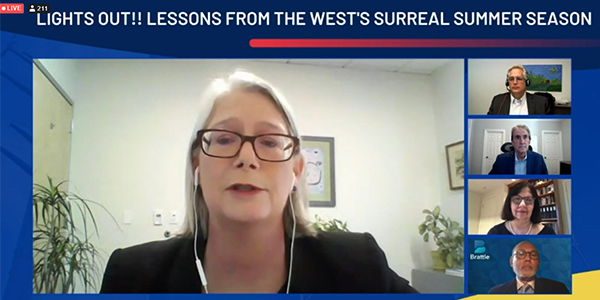Rolling blackouts, massive wildfires and extreme heat produced a “surreal summer” in the Western Interconnection that panelists examined during the National Association of Regulatory Utility Commissioners’ annual meeting Wednesday.
The blackouts ordered by CAISO on Aug. 14-15 were not the only extraordinary measures taken to deal with a heat wave that outstripped even normal August highs and sent the temperature in Death Valley to 130 degrees Fahrenheit on Aug. 16.
“This wasn’t just a California event,” said Washington Utilities and Transportation Commissioner Ann Rendahl, who moderated the online panel entitled “Lights Out! Lessons from the West’s Surreal Summer Season.”

Washington UTC Commissioner Ann Rendahl moderated a NARUC panel on the West’s ‘surreal summer.’ | NARUC
“The excessive heat across the Western United States resulted in stress for many balancing authorities due to the high air conditioning demand,” Rendahl said. “WECC identified 18 emergency alerts from balancing authorities across the West between Aug. 14 and Aug. 19. A similar event could have occurred in several areas in the West.”
The summer wildfires that blanketed the West in smoke and shut down power in parts of California and Oregon added to the stress on residents and the grid, she said.
Learning from the summer’s events to avoid future blackouts is vital, Rendahl said.
Other panelists were former FERC Commissioner Cheryl LaFleur, a member of the ISO-NE Board of Directors; Ahmad Faruqui, an energy economist and principal with the Brattle Group; David Geier, COO of San Diego Gas & Electric; and Mark Rothleder, COO of CAISO.
Geier spoke about his utility’s lauded efforts to prevent fires in the past decade, such as grid hardening, weather monitoring and public safety power shutoffs (PSPS) to keep utility equipment from sparking blazes.
Rothleder walked through the findings of a preliminary report on the causes of the August blackouts, including day-ahead forecasting failures, untimely exports and limited transmission to import energy from neighboring states. (See CAISO Says Constrained Tx Contributed to Blackouts.)
Faruqui said the summer’s blackouts and PSPS events reminded him unpleasantly of the Western energy crisis and rolling blackouts of 2000/01. This time, his family had battery backup in their home, but hundreds of thousands of customers lost power and air conditioning amid triple-digit temperatures and thick smoke from wildfires.
“We felt we were living at the edge of darkness,” Faruqui said.
Talking with colleagues around the world, he said, he realized “everyone was watching what was happening in California.”
Spur to Regionalization?
LaFleur said that to prevent future outages, California and other Western states pursuing aggressive decarbonization must work harder to ensure they have adequate resources. Arizona, California, Nevada, New Mexico and Washington have ambitious clean energy goals, with other states expected to follow suit.
Renewable resources are not the problem, LaFleur said. The extreme weather conditions and fires of August argue for more carbon-free energy to stem climate change, she said.
But states switching to large amounts of wind and solar need dispatchable resources for the times when wind and solar drop offline, she said.
“I think part of the issue in California, systemically, has been not enough dispatchable resources at the right time to balance the solar and wind,” LaFleur said. “California has been very decisive about what resources it doesn’t want, but it’s suffered from a pattern of closing resources before the ones that were supposed to replace them were online. That included losing 10,000 MW of gas in recent years, [while] planning on new resources, including large-scale storage that’s not online yet.”
Studies have shown states can substantially decarbonize the grid while retaining gas plants that are infrequently used but available when needed, she said.
The other big issue is who’s in charge of resource adequacy, she said. RA planning can only work with “clear lines of authority and clear handoffs to make sure that whoever has their hand on the switch running the grid has enough energy when they need it.”
California has a “particularly tangled and complex set of responsibilities for making sure there’s enough resources available to keep the lights on,” LaFleur said. The state Energy Commission forecasts long-term demand; the Public Utilities Commission orders yearly procurement; the ISO runs the grid on the resources it is given, with limited backstop purchasing authority; and the legislature dictates what type of resources are acceptable for load-serving entities to buy, she noted.
The agencies and the ISO need to work together better and with FERC to make sure there are adequate resources going forward, she said.
Western regionalization could also help California and other states ensure there’s sufficient energy while pursuing decarbonization, she said. In past years, California lawmakers have considered efforts to change CAISO’s governance structure to allow it to lead a Western RTO, but without success. Other Western states have also resisted the idea. (See Western RTO Proponents Vow to Keep Trying.)
“I hope that this summer’s events are a spur to think about that one again,” LaFleur said.


